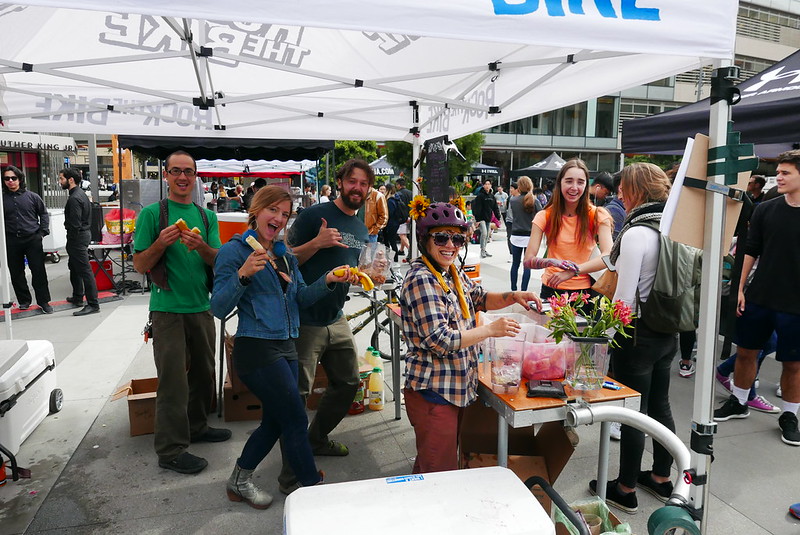1000 smoothies in 6 hours?!

Last Wednesday we did a big gig at the Cal Campus in Berkeley. The client / partner was Under Armour and their event firm Engine Shop. The goal was 1000 smoothies in 6 hours with 10 Fender Blender Pros. We nearly hit the goal. We got a lot of things right and learned a lot too, and here’s a report of all that.
We showed up with a fully packed van at 8:30AM for an 11 O’Clock start time. Unloading with 4 people took 30 minutes, including positioning the bikes. By 9AM we were up to 5 people. With this size group we were able to set up the entire smoothie booth operation in 2 hours with time for coffee!

Crew size:
Here were the roles we had at the peak:
With this size crew we were able to move people through the line at a comfortable pace. The line did get to be about 10 people long at times. The biggest bottleneck seemed to be prepping the smoothie pitchers themselves, and then process of going from the tent to the bikes. Our partner wanted each person to pedal their own smoothie. That was a great goal because it upped the activity and the fun. It did slow down the total number of smoothies we were able to pour, however!
A big sign would have helped us show people what we wanted them to do. We used our voices and told students to: download the Under Armour fitness app, sign the waiver, choose their flavor, get their pitcher, bring their pitcher to a bike. Then our coaches helped put it on the blender base with the bungee hook, then the students blended, we helped them pour, they drank their smoothie, then they or a coach brought the dirty pitchers to the wash area. This happened about 750 times in 6 hours!
There weren’t any small kids so seat height wasn’t a big issue. Everyone was between 1 foot of each other so a lot of the seats ended up at a medium height. We still recommend changing the height for every rider but the consistent age group made this less necessary.
Shopping took 2 people 4 hours the day before. We brought 3 big white coolers and put the frozen ingredients in the coolers and packed ice around them. The frozen blueberries were not very frozen at the start of the next day (and it wasn’t even a hot day). Same for the mango cubes; they were softening too. We needed a better way of ensuring frozen food stays frozen. Shopping the day before is borderline. Transferring to a chest freezer would be a big step forward. Taking the frozen blues and raspberries out of the cardboard boxes so that their inner plastic bags were up against ice would have helped a lot. The ice stayed cold enough to use!
Here are the 2 recipes we used:
– Banana
– Apple Juice, Lemonade, Almond Milk.
We did something on this recipe that I’ve been wanting to do for a while, which is mix all the smoothie liquids in one big liquid dispenser to reduce the number of steps of prepping a smoothie. We used a Gatorade 5 gallon cooler. It worked really well. You can count seconds as you pour to get a consistent amount of liquid in each pitcher.
This was a very cost effective recipe. No frozen anything. We used only one 2 pound bag of organic cacao (only $11 ) We also used expensive Vega protein powder but again, you don’t need a lot per smoothie.
We shopped at Restaurant Depot in Oakland and CostCo in San Leandro.
Restaurant Depot did not have a lot of organic frozen options. We got non organic blues and raspberries and organic Acai. The frozen fruit section was nearly cleaned out when we arrived. This place was good for non organic bananas. We bought 120 lbs of bananas for $51 (3 cases, $17 each. That’s $0.42 per pound for bananas and they were the perfect degree of yellow. Way better than Trader Joes and other grocery stores).
Organic Almond milk was 23.39 for a case of 12 (<$2 for each 32oz almond milk, pretty good). We bought 4 cases Almond milk and used just over 3 cases.
Next we went to Costco.
Costco is good for:
Bags of organic Power Greens
Lastly we bought Mint at Whole Foods $2/bunch for small bunches. Later, $1.50 at Berkeley Bowl for same. We bought a total of 13 small bunches mint, and we ran out. We needed more like 20 bunches.
– 64 pounds of frozen fruit
– 120 pounds of bananas
– 160 pounds of ice
– 24 pounds of watermelon
– 26 gallons of smoothie liquids. We had 4.5 gallons of liquids left over and about 1/3 of the Acai packs.
I’m a bit surprised that our crew of 5-7 people working hard for 6 hours with 10 bikes and having a huge amount of ingredients wasn’t enough to serve 1000 smoothies even with the requirement that each person blend their own smoothie. I think the process of making students download the app and sign the waver slowed things down and reduced the total number of takers.




